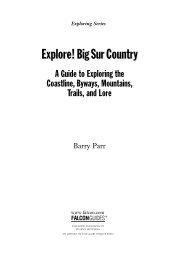A Field Guide to Poison Ivy, Poison Oak, and ... - Falcon Guides
A Field Guide to Poison Ivy, Poison Oak, and ... - Falcon Guides
A Field Guide to Poison Ivy, Poison Oak, and ... - Falcon Guides
Create successful ePaper yourself
Turn your PDF publications into a flip-book with our unique Google optimized e-Paper software.
Chapter 1<br />
The Toxic Trio<br />
Nature’s hostility <strong>to</strong> human interference is usually manifest<br />
on a large scale, in such phenomena as global warming<br />
<strong>and</strong> ozone-layer deterioration. These retributions<br />
affect all living things. But the revenge wrought by poison<br />
ivy, poison oak, <strong>and</strong> poison sumac is reserved exclusively<br />
for the human inhabitants of planet Earth. Bears, birds,<br />
<strong>and</strong> other wild creatures eat the berries <strong>and</strong> sleep among<br />
the leaves with no ill effects.<br />
The most common ill effect suffered by humans is a<br />
dermatitis caused by contact with the plants’ oils. Rashes<br />
<strong>and</strong> blisters erupt on the skin, sometimes oozing <strong>and</strong> weeping,<br />
<strong>and</strong> always causing a pernicious itch. Less common<br />
<strong>and</strong> more dangerous is contact with the smoke of burning<br />
poison ivy, oak, or sumac plants or their parts. The oil that<br />
causes the allergic reaction is carried in smoke <strong>and</strong> can<br />
l<strong>and</strong> on skin <strong>and</strong> in eyes <strong>and</strong> ears <strong>and</strong> can even be inhaled,<br />
causing serious lung problems.<br />
In North America, poison ivy <strong>and</strong> poison oak grow<br />
happily from Mexico <strong>to</strong> Nova Scotia, except in the desert<br />
areas of the southwestern United States. Their growth<br />
requirements are simple. They prefer an elevation under<br />
4,000 feet. They prefer sunshine but will do without. They<br />
favor drier soils but <strong>to</strong>lerate moisture. They love ground<br />
that has been disturbed <strong>and</strong> multiply freely on road<br />
embankments <strong>and</strong> along forest trails. They spread happily<br />
in city parks, such as Central Park in New York City, <strong>and</strong> in<br />
suburban backyards.<br />
Although poison ivy, oak, <strong>and</strong> sumac are essentially the<br />
same plant, poison ivy resides in the eastern, midwestern,








